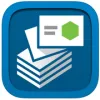Take a look inside 10 images
Math Vocabulary Cards, by the Math Learning Center
Pros: Easy controls, plus lots of concepts across the K–5 standards, with multiple representations, examples, and definitions for each.
Cons: No-frills, institutional interface lacks a clear shuffle option, and there's no progress counter or checklist to monitor mastery.
Bottom Line: For concept review at any age, this is a nice prepackaged option, but it doesn't leverage the technology's strength to improve learning outcomes.
Try structuring your lesson like this: Start with a discovery activity where students can really get their hands dirty with a new mathematical concept, add in some formal scaffolding where you introduce the official vocabulary words and definitions, work through some guided practice, and then introduce Math Vocabulary Cards to hammer those terms in. Without a lot of practical familiarity, this app isn't going to help much.
Math Vocabulary Cards could also be a great choice as part of a summative assessment review. Let your students use it at home or during in-class review time before a big exam (especially any state testing, given that the decks include plenty of standardized test-specific language) in addition to their usual review problem sets or projects. It would also be good to use at the beginning of units that require lots of prior knowledge, especially for older students.
Math Vocabulary Cards is a flash card app that covers math words and concepts for all math Common Core State Standards from kindergarten through fifth grade. Users choose which deck or combination of decks to use, broken up by grade (K–2 and 3–5) and subject, and cards are then randomly displayed. Each card has three sections: the word, the definition, and illustrated examples to demonstrate the concept. These panes can be toggled as shown or hidden with each new card, so players can start with any combination of the three revealed.
Simple forward/back controls allow the user to navigate the cards, with options to jump to the beginning or end of the deck. To reshuffle cards, users must unselect the chosen decks and then reselect them. The cards can be shown in English or Spanish on the fly, with one tap, making it into a bilingual glossary at the touch of a button.
The absolute best way to learn specialized vocabulary words is to use them in practice, because context is what glues words to meaning in the brain. Assuming you're already working to do that in the classroom, Math Vocabulary Cards is an excellent choice for review or support. Compared to more traditional flash cards that only have the word and the definition, this version adds illustrated examples to bridge that gap between word and meaning, and it does so quite well. The examples often include multiple representations of the word, which leads to larger learning gains than a single representation, according to current research.
For words that students haven't seen in context, Math Vocabulary Cards won't do much, even with the great illustrations. It may be very useful for review, but it's not a good learning tool for introducing new concepts.



















